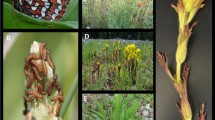Abstract
Several Longitarsus flea beetle species sequester pyrrolizidine alkaloids acquired from their Asteraceae and Boraginaceae host plants. We carried out feeding and injection experiments using radioactively labeled pyrrolizidine alkaloids to investigate the physiological mechanisms of uptake, metabolism and storage of alkaloids in adult beetles. We examined six Longitarsus species belonging to different phylogenetic clades in a comparative approach. All species that accepted pyrrolizidine alkaloids in a preceding food choice study showed the ability both to store pyrrolizidine alkaloid N-oxides and to metabolize tertiary pyrrolizidine alkaloids into their N-oxides. Regardless of whether the beetles' natural host plants contain pyrrolizidine alkaloids or not, these species were found to possess an oxidizing enzyme. This oxygenase appears to be specific to pyrrolizidine alkaloids: [3H]Atropine and [14C]nicotine, two alkaloids not related to pyrrolizidine alkaloids, were neither stored nor N-oxidized by any of the tested species. One species, L. australis, that strictly avoids pyrrolizidine alkaloids behaviorally, exhibited a lack of adaptations to pyrrolizidine alkaloids on a physiological level as well. After injection of tertiary [14C]senecionine, beetles of this species neither N-oxidized nor stored the compounds, in contrast to L. jacobaeae, an adapted species that underwent the same treatment. L. jacobaeae demonstrated the same efficiency in N-oxidation and storage when fed or injected with tertiary [14C]senecionine.





Similar content being viewed by others
References
Brown KS (1984) Adult-obtained pyrrolizidine alkaloids defend ithomiine butterflies against a spider predator. Nature 309:707–709
Brown KS, Trigo JR (1995) The ecological activities of alkaloids. In: Cordell G (ed) The alkaloids, vol 47. Academic Press, New York
Craig J, Purushothaman KK (1970) An improved preparation of tertiary amine N-oxides. J Org Chem 35:1721–1722
Döberl M (1994) 11. Unterfamilie: Alticinae. In: Lohse GA, Lucht WH (eds) Die Käfer Mitteleuropas. Goecke & Evers, Krefeld
Dobler S (2001) Evolutionary aspects of defense by recycled plant compounds in herbivorous insects. Basic Appl Ecol 2:15–26
Dobler S, Haberer W, Witte L, Hartmann T (2000) Selective sequestration of pyrrolizidine alkaloids from diverse host plants by Longitarsus flea beetles. J Chem Ecol 26:1281–1298
Douget S (1994) Coléoptères, Chrysomelidae, vol 2. Alticinae. Féderation Francaise des Sociétés de Sciences Naturelles, Paris
Gonzales A, Rossini C, Eisner M, Eisner T (1999) Sexually transmitted chemical defense in a moth (Utetheisa ornatrix). Proc Natl Acad Sci USA 96:5570–5574
Haberer W, Dobler S (1999) Quantitative analysis of pyrrolizidine alkaloids sequestered from diverse host plants in Longitarsus flea beetles (Coleoptera, Chrysomelidae). Chemoecology 9:169–175
Hartmann T (1994) Senecio spp.: biochemistry of the formation of pyrrolizidine alkaloids in root cultures. In: Bajaj YPS (ed) Biotechnology in agriculture and forestry, medicinal and aromatic plants VI. Springer, Berlin Heidelberg New York
Hartmann T (1999) Chemical ecology of pyrrolizidine alkaloids. Planta 207:483–495
Hartmann T, Ober D (2000) Biosynthesis and metabolism of pyrrolizidine alkaloids in plants and specialized insect herbivores. Top Curr Chem 209:207–243
Hartmann T, Witte L (1995) Pyrrolizidine alkaloids: chemical, biological and chemoecological aspects. In: Pelletier SW (ed) Alkaloids: chemical and biological perspectives. Pergamon Press, Oxford
Hartmann T, Witte L, Ehmke A, Theuring C, Rowell-Rahier M, Pasteels JM (1997) Selective sequestration and metabolism of plant derived pyrrolizidine alkaloids by chrysomelid leaf beetles. Phytochemistry 45:489–497
Hartmann T, Theuring C, Schmidt J, Rahier M, Pasteels JM (1999) Biochemical strategy of sequestration of pyrrolizidine alkaloids by adults and larvae of chrysomelid leaf beetles. J Insect Physiol 45:1085–1095
Hartmann T, Theuring C, Witte L, Pasteels JM (2001) Sequestration, metabolism and partial synthesis of tertiary pyrrolizidine alkaloids by the neotropical leaf-beetle Platyphora boucardi. Insect Biochem Mol Biol 31:1041–1056
Lindigkeit R, Biller A, Buch M, Schiebel HM, Boppré M, Hartmann T (1997) The two faces of pyrrolizidine alkaloids: the role of the tertiary amine and its N-oxide in chemical defense of insects with acquired plant alkaloids. Eur J Biochem 245:626–636
Mattocks AR (1967) Detection of pyrrolizidine alkaloids on thin-layer chromatograms. J Chromatogr 27:505–508
Naumann C, Hartmann T, Ober D (2003) Evolutionary recruitment of a flavin dependent monooxygenase for the detoxification of host-plant acquired pyrrolizidine alkaloids in the alkaloid defended arctiid moth Tyria jacobaeae. Proc Natl Acad Sci USA (in press)
Orr AG, Trigo JR, Witte L, Hartmann T (1996) Sequestration of pyrrolizidine alkaloids by larvae of Tellervo zoilus (Lepidoptera: Ithomiinae) and their role in chemical protection of adults against the spider Nephila maculata (Araneidae). Chemoecology 7:68–73
Pasteels JM, Termonia A, Windsor DM, Witte L, Theuring C, Hartmann T (2001) Pyrrolizidine alkaloids and pentacyclic triterpene saponins in the defensive secretions of Platyphora leaf beetles. Chemoecology 11:113–120
Roeder E (1995) Medicinal plants in Europe containing pyrrolizidine alkaloids. Pharmazie 50:83–98
Rowell-Rahier M, Pasteels JM, Alonso-Mejia A, Brower LP (1995) Relative unpalatability of leaf beetles with either biosynthesized or sequestered chemical defense. Anim Behav 49:709–714
Trigo JR, Witte L, Brown KSJ, Hartmann T, Barata LES (1993) Pyrrolizidine alkaloids in the arctiid moth Hyalurga syma. J Chem Ecol 19:669–679
Acknowledgements
This study was supported by grants from the Deutsche Forschungsgemeinschaft (to S.D. and T.H.), from the Fonds der Chemischen Industrie (to T.H.) and by a Boehringer Ingelheim Fellowship to I.N. All experiments described comply with the current laws of the Federal Republic of Germany.
Author information
Authors and Affiliations
Corresponding author
Additional information
Communicated by G. Heldmaier
Rights and permissions
About this article
Cite this article
Narberhaus, I., Theuring, C., Hartmann, T. et al. Uptake and metabolism of pyrrolizidine alkaloids in Longitarsus flea beetles (Coleoptera: Chrysomelidae) adapted and non-adapted to alkaloid-containing host plants. J Comp Physiol B 173, 483–491 (2003). https://doi.org/10.1007/s00360-003-0356-6
Accepted:
Published:
Issue Date:
DOI: https://doi.org/10.1007/s00360-003-0356-6




